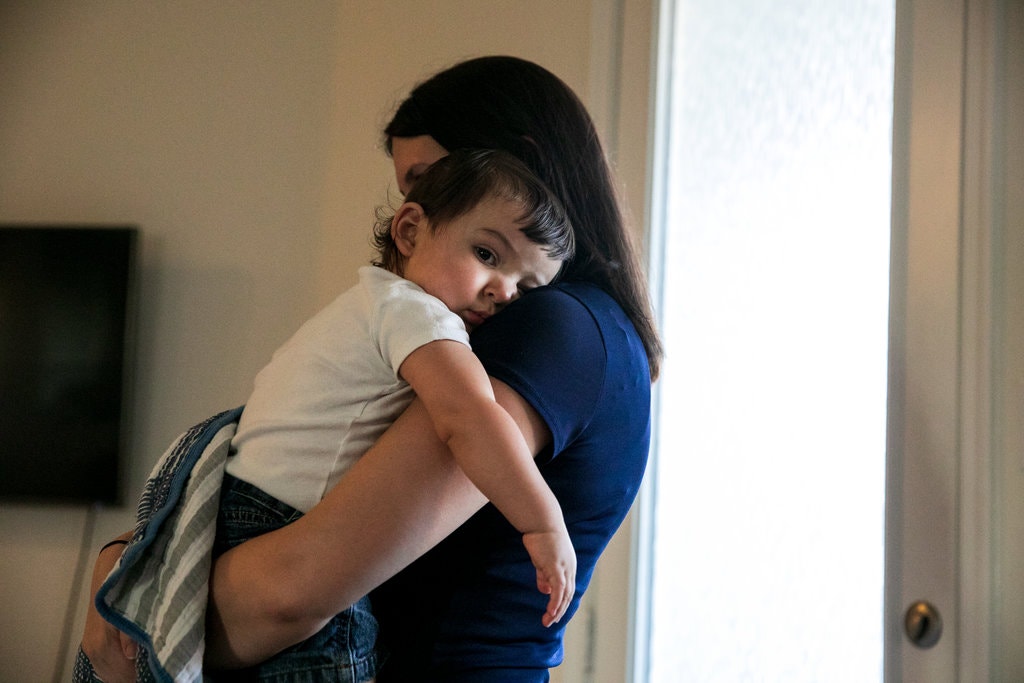Medicaid Covers a Million Fewer Children. Baby Elijah Was One of Them.
Officials point to
rising employment, but the uninsured rate is climbing as families run
afoul of new paperwork and as fear rises among immigrants.
HOUSTON
— The baby’s lips were turning blue from lack of oxygen in the blood
when his mother, Kristin Johnson, rushed him to an emergency room here
last month. Only after he was admitted to intensive care with a
respiratory virus did Ms. Johnson learn that he had been dropped from
Medicaid coverage.
The 9-month-old,
Elijah, had joined a growing number of children around the country with
no health insurance, a trend that new Census Bureau data suggests is
most pronounced in Texas and a handful of other states. Two of Elijah’s
older siblings lost Medicaid coverage two years ago for reasons Ms.
Johnson never understood, and she got so stymied trying to prove their
eligibility that she gave up.
“I’ve
been on this emotional roller coaster,” Ms. Johnson, 34, said of
Elijah’s loss of coverage, an error that happened apparently because she didn’t respond quickly enough to a letter asking for new proof of income. “It’s been a very scary month.”
Nationwide,
more than a million children disappeared from the rolls of the two main
state-federal health programs for lower-income children, Medicaid and
the Children’s Health Insurance Program, between December 2017 and June,
the most recent month with complete data.
Some
state and federal officials have portrayed the drop — 3 percent of
enrolled children — as a success story, arguing that more Americans are
getting coverage from employers in an improving economy. But there is
growing evidence that administrative changes aimed at fighting fraud and
waste — and rising fears of deportation in immigrant communities — are
pushing large numbers of children out of the programs, and that many of
them are now going without coverage. The declines are concentrated in a minority of states; in other places, public coverage has actually increased.
An
analysis of new census data by The New York Times shows the number of
children in the United States without any kind of insurance rose by more
than 400,000 in a two-year period, between 2016 and 2018, after decades
of progress toward universal coverage for children.
Some
of the states that saw the largest increases in uninsured children —
like Tennessee and Texas — were those that created rules to check the
eligibility of families more frequently or that reset their lists with
new computer systems. In some states with large immigrant populations
like Florida, doctors and patient advocates report growing concern among
parents that signing up their children (who are citizens) may hurt
their own chances of getting a green card or increase their risk of
deportation.
When
asked about the drop in Medicaid enrollment, government officials tend
to point first to the improved economy, which has undoubtedly enabled some families to gain jobs with private insurance.
“Unemployment
remains low, wage growth is up, & we now see fewer people relying
on public assistance,” Seema Verma, the administrator of the Centers for
Medicare and Medicaid Services, wrote on Twitter in April. “That’s
something to celebrate.”
In many states with large declines, like Tennessee and Missouri, officials cited the stronger job market.
Kelli
Weldon, a spokeswoman for the Texas Health and Human Services
Commission, cited “record-low unemployment levels” for its contraction
in Medicaid enrollment.
But the census
analysis also shows increases in the rate of uninsured children in
states with enrollment declines, including Tennessee, Texas, Idaho and Utah.
In Texas, the number of uninsured children rose by around 120,000 between 2016 and 2018.
State officials increased paperwork requirements in 2014 for families
covered under both Medicaid and CHIP, which serves children whose income
is slightly higher than Medicaid’s.
Instead of checking eligibility once a year, as many states do, Texas enrolls children for six months and then checks databases for four consecutive months to ensure family income is still low enough to qualify.
If the databases show the income has gone over the limit, families are
notified by mail and have 10 days to prove otherwise or lose Medicaid.
A bipartisan bill in the state legislature this spring sought to make income checks annual again after data suggested several thousand eligible children were being dropped from Medicaid each month, but it never got a vote.
Other
states have also begun checking family incomes more often, or removing
families who may have moved if mail is returned to the state.
“The
way they are doing this seems clearly designed to throw people off this
program,” said Eliot Fishman, a senior director at the consumer group
Families USA, who was a top Medicaid official in the Obama
administration.
When Tennessee updated its enrollment computer system in 2016, it generated thousands of errors.
Medicaid and CHIP enrollment in the state has declined by more than
55,000 children since January 2018, according to the Georgetown Center
for Children and Families.
Tennessee’s Medicaid director, Gabe Roberts,
said that besides the improved economy, the decline in enrollment was a
result of updating the computer system and clearing up a backlog of old
cases.
Gordon Bonnyman, co-founder
of the Tennessee Justice Center, which has been helping families
struggling with lost coverage, was skeptical, saying the state response
has revealed “a remarkable lack of curiosity about what happened to
these kids.”
The census shows that about 25,000 more children there have become uninsured since 2016.
A large body of evidence shows that Medicaid coverage for children has lasting effects on their lives, improving their health, educational attainment and even adult earnings.
In 2010, the Affordable Care Act made it easier for states to check
whether families qualified for Medicaid without requiring them to fill
out paperwork, a strategy proven to increase coverage rates. The A.C.A.
also made it harder for states to expel poor families for paperwork
errors.
The changes helped the uninsured rate among children reach its lowest level ever in 2016, with fewer than 5 percent without coverage.
Trump administration officials have not explicitly tried to limit children’s Medicaid coverage. But Ms. Verma
has repeatedly encouraged state officials to safeguard “program
integrity,” by doing more vigorous checks of enrollees’ eligibility.
More recently, her office reviewed the reductions and concluded that
problems with state computer systems may be a factor in some places.
“While
the economy is the most consistent driver of enrollment that we
observed, we have found evidence that other more state-specific factors
may be driving individual state experiences,” an agency spokesman,
Johnathan Monroe, said in an email.
Medicaid
and CHIP eligibility does depend on household income, meaning that, as
wages rise, some families may be earning too much to qualify. Yet the
patterns in coverage suggest reasons beyond improved finances. In
Tennessee, for example, the biggest declines in Medicaid enrollment have come in counties with the highest unemployment rates, a Justice Center analysis found.
History has shown that when states require more paperwork from Medicaid beneficiaries, more eligible people fall through the cracks.
Medicaid beneficiaries tend to move often; to have unstable hours and
incomes; and to have literacy challenges that can make it hard to submit
detailed renewal packages or verify their incomes frequently.
The specter of a pending “public charge” rule
— which could penalize green card applicants who use public benefits
like Medicaid — is causing many immigrant patients to decline enrollment, according to a Kaiser Family Foundation survey of community health centers. This month a federal judge temporarily blocked that rule from taking effect.
Texas leads the nation in the number of uninsured children and adults. In Houston, Maricela,
a single mother, had carefully filled out the paperwork to re-enroll
her younger two children, both citizens, in Medicaid every year since
they were born — until now. A permanent resident from El Salvador who
earns minimum wage as a hotel maintenance worker, she was so worried
about jeopardizing her status that she decided to let their coverage
lapse in August. Because of the deportation risk, she agreed to share
only her first name.
“My worst fear is
that I could end up without my legal status and be separated from my
children,” Maricela said this month at Epiphany Community Health
Services, a nonprofit group that helps people find health coverage.
“That would be fatal for me.”
Her
older son, 11, has asthma; at his last doctor’s visit before his
coverage ended, she pleaded for extra medicine. His main treatment, a
generic version of Singulair, could cost $150 a month without insurance.
Listening to him cough at night, she finally decided to take the risk
and re-enroll both boys in Medicaid.
“I had to do it,” she said. “But I’m afraid.”
Dr.
Sogol Pahlavan, a Houston pediatrician, said the rate of her patients
on Medicaid dropped to 70 percent in 2018, from 75 percent a year
earlier. The number of uninsured in her practice of 10,000 patients has
grown commensurately, with families citing both the impending public
charge rule and administrative hurdles.
“It’s
definitely going to affect the community, because somebody ultimately
has to bear that cost,” she said. “These kids are still here; their
chronic disease isn’t going away just because they’re losing health
coverage.”
For Ms. Johnson, Elijah’s stay at Texas
Children’s Hospital led to an appointment with an enrollment counselor
who helped her try to figure out what had happened. Trying to re-enroll
her older children earlier this year, she was asked for proof of income
and missed the 10-day window to provide it; that may be why Texas
dropped Elijah from Medicaid even though he qualified because he was a
baby.
All of her children are now
re-enrolled. But she has started receiving thousands of dollars in bills
from the baby’s hospital stay — bills she is counting on Medicaid to
cover retroactively. And she is haunted by what might have happened if
the hospital where she took Elijah had considered the case nonurgent and
turned them away.
“I went to the E.R.
thinking he had insurance,” she said. “If the receptionist had not seen
him turning blue, she might have just said, ‘He’s not covered, so we
can’t see him today.’ I do think about that.”






Comments
Post a Comment